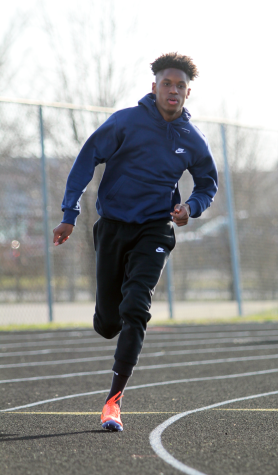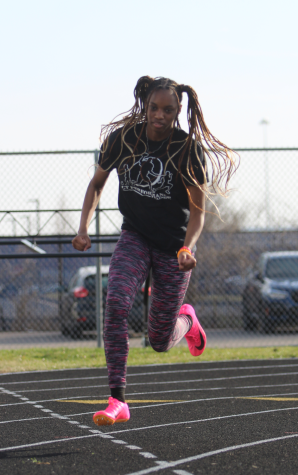STORY LEAH ARNETT | PHOTOGRAPHY AND INFOGRAPHIC CARA RAIFORD

Sitting in class, they would count down the minutes until recess. Once the bell rang, the two fifth graders bolted outside of Winton Woods Elementary, ready for recess. Standing next to each other, lined up at the edge of the blacktop, they looked down, looked at each other, then looked down again. Three, two, one, GO! While their classmates watched in awe at their pure speed, the two went head-to-head every single day during recess– always wanting to defeat one another.
East sophomore twins Lena and Greg James have since added to their elementary school reputation. Competing in indoor track during the winter and outdoor track during the spring, the twin siblings plan to accomplish big goals with the help of one another.
Coming from a family of athletes, Lena and Greg both have high expectations for their track and field careers. The two have been running Amateur Athletic Union (AAU) track since they were five years old and have been setting themselves up for success ever since then. Their older sister Camiyah James, who graduated from East in 2021, is a long jumper for the track and field team at the University of Cincinnati. Both twins plan to follow in her footsteps.
“I do plan to run in college, but I am not sure what is after that,” Lena, who primarily sprints, told Spark. “For now, I just have big goals for the events I run.” During her freshman year, Lena ran a 24.92-second 200-meter dash, the second fastest time in the Greater Miami Conference (GMC).

Out of roughly 150 kids on East’s track roster, Lena and Greg are part of the 20 athletes that participate in both indoor and outdoor track and field. East track head coach Rodney Heath says that his athletes that do both enjoy a huge benefit because they are constantly practicing and attending meets throughout the winter and spring.
“These kids get an advantage because they are doing this now,” Heath, the eighth-year head
coach, told Spark. “When they get to outdoor [track], they are so much further than any other kids that are coming out.”
Indoor track is essentially practice for outdoor, although Lena feels that indoor is more nerve-racking because coaches usually bring the best of the best to compete.
“Indoor is a lot more serious because it is usually the fastest kids on the team, and the coaches take everything seriously,” Lena says. “[It is] unlike outdoor where the whole team is there.”
Depending on where an indoor meet is
located, the indoor tracks differ in size. Typically, they are either 200 or 300 meters long, which is different from traditional outdoor tracks that are 400 meters long. The events during indoor and outdoor are the same, however, meaning that the runners have to take double the amount of turns while competing inside.

Despite the variance in the size of tracks, the tall, 6 ‘4, and rangy Greg managed to hit a personal record (PR) of 22.54 seconds this past indoor season while running the 200-meter dash.
“For me, I think indoor is easier because I am longer, and it is better for me to extend,” Greg says, who runs both the 200 and 400-meter dash.
Heath’s major concern about indoor running is keeping his athletes healthy. One problem is that the team is obligated to practice in the school hallways throughout the winter months. Running on hard floors makes runners more injury-prone. Therefore Heath stresses that his athletes do not train by themselves.
“When we are indoor, we train for three days tops because of the pounding. I do not want them running on the gym floor too much because it affects their shins,” Heath says. “We are making sure that the kids are getting the workouts they need without overdoing it.”
Now that the winter season has concluded, the twins have big goals for this upcoming spring. Both specializing in the 400 and 200, Lena and Greg have the same love for sprinting, making them more eager to achieve their goals. Lena wants to hit a PR of 24.6 seconds in the 200 and 59 seconds in the 400. Greg wants to reach a sub 50 seconds for the 400 and a sub 22 seconds for the 200.
Both siblings have their fair share of obstacles. Lena experiences trouble staying in the correct mindset, a common habit among track and field athletes.
“I am often psyching myself out without even realizing it,” Lena says. “My mentality is definitely a huge part of track.”
Track is a mixture of being a physical and mental athlete. The individuality of running allows the athletes’ emotions to be exposed easily, meaning that keeping a good mental state is imperative. Heath’s biggest struggle as a track coach is keeping his kids, like Lena, in a positive attitude even if they fail to reach a goal.
“If they want to reach a goal and they do not reach it for the first time, they kind of get down on themselves,” Heath says. “That is why we are here as coaches to motivate them and make sure they understand that it does not stop here, and there is a bigger picture at the end.”
Greg’s biggest challenge as a runner is more physical. He was born with a defect in his patella bone which causes pain in both of his knees and shins while he is running.
“I have to wear two knee braces during every practice and every race,” Greg says. “There is just no way of getting around it.”
Even with these minor problems, the twins get through everything with each other. Before meets, during meets, and after meets, they are always together. Lena and Greg’s sibling relationship allows them to overcome any problem they may face while they are running.
“If she did good, I would be like, ‘you did really good,’ and she will be like, ‘I gave it my all.’” Greg says. “Lena and I keep it real honest. If we did not do our best, we would communicate that.”
Now, instead of racing on the blacktop, they race at competitive meets on rubber tracks. Instead of going against each other, they are now on the same team. No matter what, the James twins remain the strongest sprinting duo.








































































































